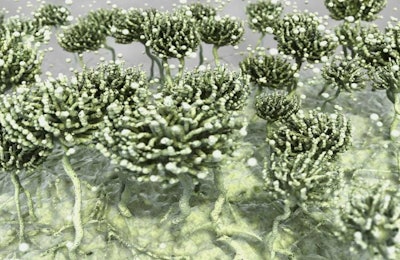
Although several other mycotoxins are more common in crops around the world, aflatoxin poses a significant threat and should not be ignored, according to Dr. Timothy Jenkins, product manager at Biomin.
Deoxynivalenol (DON), fumonisin (FUM) and zearalenone (ZEN) are much more prevalent than aflatoxin in many regions of the world, but in warmer regions such as Asia and the Middle East, aflatoxin poses a significant threat.
Jenkins said droughts are a “real risk factor” for levels of aflatoxin, with aflatoxin levels showing up a bit more in parts of Europe.
“Even in Europe, we have the occasional aflatoxins,” Jenkins said. “In North America, we are concerned with a more sporadic occurrence of aflatoxin.”
He said climate change may be contributing to the higher incidence of aflatoxin in some regions.
“It is still, by no means, common in feeds grown in Europe or North America,” he said. “With climate change effects, more risk of drought, and generally higher temperatures … then that might well be one thing we should expect in regions where it has been sporadic.”
Aflatoxin exposure results in immune suppression in animals and is dangerous to humans because of its carcinogenic properties, Jenkins said. When milk-producing animals ingest aflatoxin-contaminated feed, the aflatoxin can carry over into the milk and, subsequently, to any human who consumes the milk. And, in areas at very high risk of aflatoxin, there is the risk of carryover into meat.
“The high potential for carcinogenic effects gets a lot of attention,” Jenkins said.
How to mitigate aflatoxin risk
Jenkins said growers should use an effective binding approach to reduce the aflatoxin that gets through the animals’ systems, therefore controlling the impact the aflatoxin will have on immune suppression in the animal.
Biomin produces an aflatoxin binder, which he said is the only one that has achieved registration in the European Union. While other binders are effective against aflatoxins, they may also reduce the amount of vitamins available to the animal and interfere with vaccine efficacy, he said.
To minimize the risk of aflatoxin contamination in feed, Jenkins said feed manufacturers should analyze feed ingredients individually before mixing. He advised limiting environmental stress on crops, such as insect infestation; inspecting the quality of the grain before putting it into storage; and adequately drying the grain.
“Take care with the temperature of the grain so there is no condensation forming on the edges of the storage silo that will provide areas of moisture for the fungi to grow on,” he said.
Jenkins said aflatoxin can be detected in very high levels on individual grains, so careful sampling should be conducted in order to find a good representative sample or to pick up on hot spots.

















